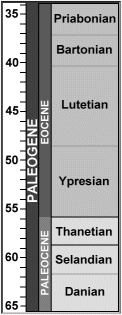| |

Striatolamia has been traditionally assigned to , however,
Cappetta and Nolf (2005) claimed to follow Siverson (1992)1 and included Striatolamia as a JORDAN 1898. Cunningham (2000) provided an extensive study of Striatolamia teeth, which can in most cases, help differentiate these teeth from other sand tigers, yet showed the dentition itself to be more similar to the odontaspids rather than mitsukurinids.
Another view on its phylogenetic position has been raised by Siverson (1996:835-36, pers. com. July 2008) -- it may have been derived from Anomotodon hermani SIVERSON 1992 and "thus in my view Striatolamia is neither an odontaspid nor a mitsukurinid but a lamniform of uncertain familial affinity having evolved an odontaspid-like dentition convergently."2
Striatolamia is represented by two named species in North America, S. striata (WINKLER 1874a) from the Palaeocene & early Eocene and S. macrota AGASSIZ 1843 from the Eocene. Purdy (1998) attempted to synonymized S. striata with S. macrota and reported the latter from the Williamsburg Formation (Thanetian - Late Palaeocene) of South Carolina. These two species have also been reported from Europe and North Africa. In Western Europe, they are found in early (middle Ypresian) and middle Eocene sediments. (In Kazakhstan very large specimens are found in the Bartonian.)
 The anterior teeth of this genus have an elongated crown, sigmoid in shape when viewed laterally, which bears striations on the lingual face. Lateral cusplets are greatly reduced or absent. Kent (1994) reports these teeth (from S. macrota) reaching 5.6 cm in height. The lateral teeth are lower and broader, the striations are weaker or lacking entirely and the cusplets reduced, often appearing as no more than a scalloped heel. Teeth from the Eocene species, S. macrota, are larger than their Palaeocene counterpart and bear shorter striations. The accompanying artifical tooth-set was reconstructed from the authors' collection following 'horizontal dentition' methodology proposed by Cunningham (2000). The overall design (file positions & tooth-design) supports an odontaspid dentition of the Carcharias-type.
The anterior teeth of this genus have an elongated crown, sigmoid in shape when viewed laterally, which bears striations on the lingual face. Lateral cusplets are greatly reduced or absent. Kent (1994) reports these teeth (from S. macrota) reaching 5.6 cm in height. The lateral teeth are lower and broader, the striations are weaker or lacking entirely and the cusplets reduced, often appearing as no more than a scalloped heel. Teeth from the Eocene species, S. macrota, are larger than their Palaeocene counterpart and bear shorter striations. The accompanying artifical tooth-set was reconstructed from the authors' collection following 'horizontal dentition' methodology proposed by Cunningham (2000). The overall design (file positions & tooth-design) supports an odontaspid dentition of the Carcharias-type.
The Muddy Creek material employed by Cunningham (2000) and this author, includes teeth that appear to be stunted anteriors (LA1) and intermediate teeth of a sand tiger-design. Based on the similarities of the Striatolamia macrota and Carcharias taurus dental morphologies, as expressed in Cunningham (2000), it is reasonable to expect that many of these teeth belong to the most common sand tiger in the fauna. The presence of strong striations helps confirm those that are likely Striatolamia in origin.
Compared with the striated-crown Carcharias-like species, the Striatolamia crowns tend be more erect (less sigmoid) with stronger striations and more greatly reduced cusplets. In contrast to Striatolamia, the striations on Scapanorhynchus tend to be stronger and extend beyond the basal margin of the crown's enameloid.
Footnotes
| 1. |
It is more likley that they intended to refer to Siverson (1995) where the author described Striatolamia cederstroemi from the Danian of Sweden and ascribed the genus to . |
| 2. |
Siverson (2008) went on to comment, "I believe too much focus is devoted to the tooth morphology and dentition-design of stratigraphically young members of the genus. Would be more interesting to examine Danian specimens. The Carcharias-type of anterior tooth morphology is duplicated by phylogenetically very distantly related lamniforms (i.e., Cretalamna gunsoni) indicating that root morphology and cusp curvature in anterior teeth are somewhat unreliable indicators for an odontaspid affinity. Unrelated lamniforms with tall, narrow cusps tend to evolve a very similar dentition in the anterior hollows. Compare the first upper lateroposterior tooth of S. cederstroemi (Siverson, 1995, fig. 3O,P) with the same tooth-position in Cunningham's reconstruction and you will notice that the older Danian form is a lot more Anomotodon-like." |
Selected References (additional in Bibliography)
Agassiz, L. J. R. 1833-1844. Recherches sur les poissons fossiles. Text (5 vols; I., xlix+188 pp., II xii+310+366 pp., III viii+390 pp., IV xvi+296 pp., V xii+122+160 pp.) and Atlas (5 vols; I 10 pl., II., 149 pl., III 83 pl., IV, 61 pl., V, 91 pl.). Neuchâtel.
Cappetta, H & Nolf, D, 2005. Revision de quelques Odontaspidae (Neoselachii: Lamniformes) du Paleocene et de l'Eocene du Bassin de la mer du Nord Bulletin de l'institut Royal des Sciences Naturelles de Belgique, Sciences de la Terre 75:237-266.
Cunningham, S. B. 2000. A comparison of isolated teeth of early Eocene Striatolamia macrota (Chondrichthyes, Lamniformes), with those of a Recent sand shark, Carcharias taurus. Tertiary Research 20(1-4): 17-31.
Glikman, L., 1964. Akuly paleogena i ikh stratigraficheskoe znachenie Akademii Nauk Soyuza Sovetskikh Sotsialisticheskikh Respublik, 1-228 Moscow.
Kent, B. 1994. Fossil Sharks of the Chesapeake Region. Egan Rees & Boyer, Maryland, 146 pp.
Purdy, R. 1998. Chondrichthyan Fishes from the Paleocene of South Carolina. In: Paleobiology of the Williamsburg Formation (Black Mingo Group; Paleocene) of South Carolina, U.S.A., Albert Sanders ed. Transactions of Amer. Philo. Scty., vol 8 (4), pp 122-146.
Siverson, M., 1992. Biology, dental morphology and taxonomy of Lamniform sharks from the Campanian of the Kristianstad basin, Sweden. Palaeontology, 35 (3): 519-554.
Siverson, M., 1995. Revision of the Danian Cow Sharks, Sand Tiger Sharks, and Goblin Sharks (Hexanchidae, Odontaspididae, and Mitsukurinidae) from Southern Sweden, Journal of Vertebrate Paleontology, 15 (1): 1-12.
Siverson, M., 1996. Lamniform sharks of the mid-Cretaceous Alinga Formation and Beedagong Claystone, Western Australia. Palaeontology, Vol 39:4, pp 813-49.
1997. Sharks from the mid-Cretaceous Gearle Siltstone, Southern Carnarvon Basin, Western Australia. Journal of Vertebrate Paleontogy, Vol 17:3, pp 453-65.
Winkler, T.C., 1874a. Mémoire sur quelques restes de Poissons du Système Heersien.In:
Archives du Musée Teyler, 1878; vol. IV, (fasc. 1, 1876), pp 1-15; Extraits [1874]. Les Héritiers Loosjes, Haarlem, Belgium.
|